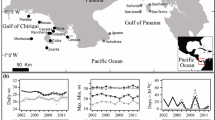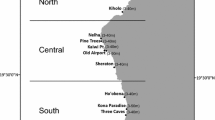Abstract
The question of whether population numbers are predictable in coral reef communities is confronted directly by trying to predict abundances of benthic taxa both within and between two reefs on the central Great Barrier Reef. Using models derived via the Group Method of Data Handling (GMDH), taxon abundances were found to be more predictable at Davies Reef than at Myrmidon Reef and a significant number of taxa showed consistent predictability patterns in all tests. For most taxa, the predictability of benthic abundances increased steadily with increasing spatial scale. Water depth figured prominently in almost all of the models obtained, emphasizing its importance as a physical determinant of local taxon abundances.
Similar content being viewed by others
References
Bradbury RH, Young PC (1981) The effects of a major forcing function, wave energy, on a coral reef ecosystem. Mar Ecol Prog Ser 5:229–241
Bradbury RH, Hammond LS, Reichelt RE, Young PC (1983) Prediction versus explanation in environmental impact assessment. Search 14:323–325
Bradbury RH, Hammond LS, Reichelt RE, Young PC (1984) Prediction and explanation as a dialectical pair in ecology. Search 15:220–222
Bradbury RH, Reichelt RE, Green DG (1985) Policy=f(theory, data, models, tools) Rational solutions to coral reef conservation. Proc 5th Int Coral Reef Symp 4:247–251
Bradbury RH, Loya Y, Reichelt RE, Williams WT (1986) Patterns in the structural typoloty of benthic communities on two coral reefs of the central Great Barrier Reef. Coral Reefs 4:161–167
Choat JH (1983) Estimation of the abundances of herbivorous fishes and their grazing rates within reef systems. In: Baker JT, Carter RM, Sammarco PW, Stark KP (eds) Proceedings of the Inaugural Great Barrier Reef Conference. James Cook University, Townsville, pp 171–177
Connell JH (1978) Diversity in tropical rain forests and coral reefs. Science 199:1302–1310
Dinesen ZD (1983) Patterns in the distribution of soft corals across the central Great Barrier Reef. Coral Reefs 1:229–236
Done TJ (1982) Patterns in the distribution of coral communities across the central Great Barrier Reef. Coral Reefs 1:95–107
Duffy JJ, Franklin MA (1975) A learning identification algorithm and its application to an environmental system. IEEE Trans Syst Man Cybern 5:226–239
Efron B (1979) Computers and the theory of statistics: thinking the unthinkable. SIAM Rev 21:460–480
Farlow SJ (1981) The GMDH algorithm of Ivakhnenko. Am Stat 35:210–215
Farlow SJ (ed) (1984) Self-organizing methods in modelling. Dekker, New York
Grassle JF (1973) Variety in coral reef communities. In: Jones OA, Endean R (eds) Biology and geology of coral reefs, vol II. Academic Press, New York, pp 247–270
Green DG, Bradbury RM, Reichelt RE (1983) Explanation, prediction and control in coral reef ecosystems. II. Models for prediction. In: Baker JT, Carter RM, Sammarco PW, Stark KP (eds) Proceedings of the Inaugural Great Barrier Reef Conference. James Cook University, Townsville, pp 213–215
Green DG, Reichelt RE, Bradbury RH (in press) Statistical behaviour of the GMDH algorithm. Biometrics
Ivakhnenko AG (1971) Polynomial theory of complex systems. IEEE Trans Syst Man Cybern 1:364–378
Ivakhnenko AG (1978) The group method of data handling in long-range forecasting. Technol Forecast Soc Change 12:213–227
Jumars PA (1976) Deep-sea species diversity: does it have a characteristic scale? J Mar Res 34:217–246
Parks PC, Ivakhnenko AG, Boichuk LM, Svetalsky BK (1975) A selforganizing model of the British economy for control with optimal prediction using the balance-of-variables criterion. Int J Comput Inf Sci 4:349–379
Pielou EC (1981) The usefulness of ecological models: a stock-taking. Q Rev Biol 56:17–31
Platt T, Denman K (1975) Spectral analysis in ecology. Ann Rev Ecol Syst 6:189–210
Reichelt RE, Bradbury RH (1984) Spatial patterns in coral reef benthos: multiscale analysis of sites from three oceans. Mar Ecol Prog Ser 17:251–257
Reichelt RE, Green DG, Bradbury RH (1983) Prediction, explanation, control in coral reef ecosystems. I. Models for explanation. In: Baker JT, Carter RM, Sammarco PW, Stark KP (eds). Proceedings of the Inaugural Great Barrier Reef Conference. James Cook University, Townsville, pp 231–235
Ross D (1983) TAXON User's Manual. CSIRO Division of Computing Research, Canberra
Sale PF (1980) The ecology of fishes on coral reefs. Oceanogr Mar Biol 18:367–421
Sale PF, Dybdahl R (1978) Determinants of community structure for coral reef fishes in isolated coral heads at lagoonal and reef slope sites. Oecologia 34:57–74
Schaffer WM (1985) Order and chaos in ecological systems. Ecology 66:93–106
Sheppard CRC (1982) Coral populations on reef slopes and their major controls. Mar Ecol Prog Ser 7:83–115
Southwood TRE (1982) Ecology—a mixture of pattern and probabilism. In: Saarinen E (ed) Conceptual issues in ecology. Reidel, Dordrecht, pp 203–214
Talbot FH, Russell BC, Anderson GRV (1978) Coral reef fish communities: unstable, high diversity systems? Ecol Monogr 48:425–440
Ulanowicz RE (1979) Prediction, chaos and ecological perspective. In: Halfron E (ed) Theoretical systems ecology. Academic Press, New York, pp 107–117
Vandermeer J (1982) To be rare is to be chaotic. Ecology 63:1167–1168
Williams DMcB (1982) Patterns in the distribution of fish communities across the central Great Barrier Reef. Coral Reefs 1:35–43
Author information
Authors and Affiliations
Rights and permissions
About this article
Cite this article
Green, D.G., Bradbury, R.H. & Reichelt, R.E. Patterns of predictability in coral reef community structure. Coral Reefs 6, 27–34 (1987). https://doi.org/10.1007/BF00302209
Accepted:
Issue Date:
DOI: https://doi.org/10.1007/BF00302209




